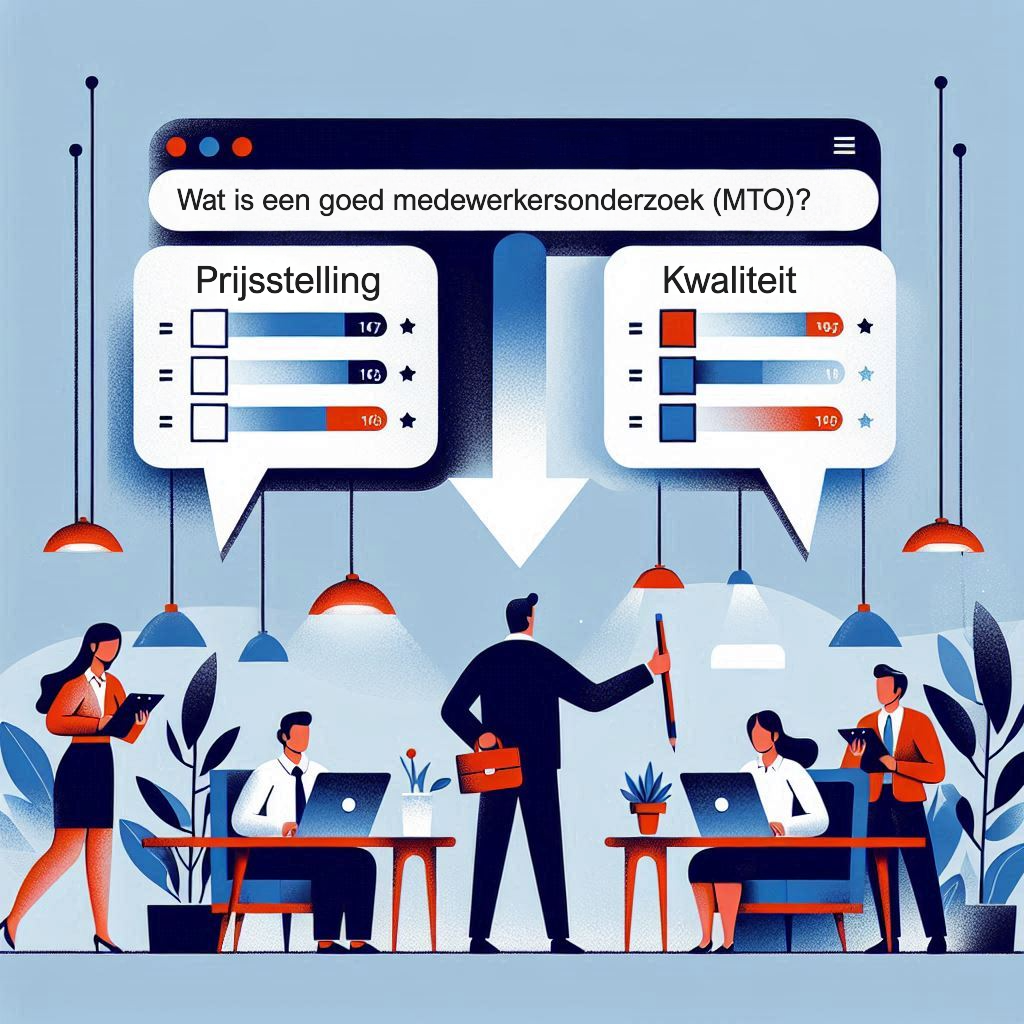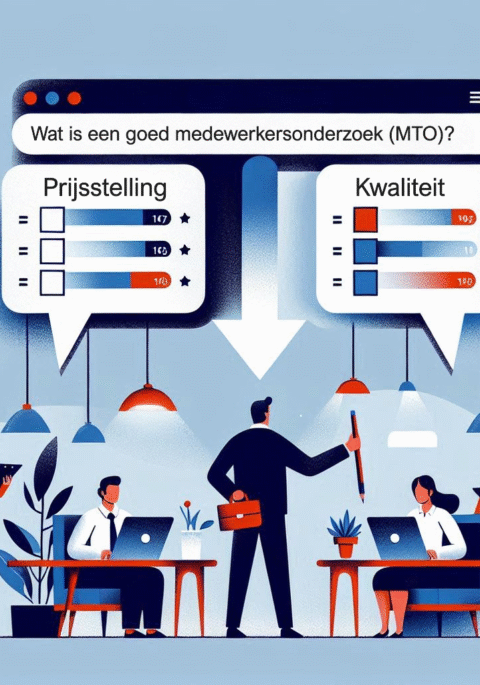A good employee survey (MTO) stands or falls with the partner you choose. Applying for a offer for an MTO may seem like a practical step, but in reality it determines the quality of your research and the usefulness of the insights. In this article, we take you through the process step by step. We will show you what to look out for, how to create a MTO offer similar and how to make the best choice in the end.

Why request a structured quotation MTO?
Many organisations mainly put price side by side, but an MTO is about more than costs. A structured approach helps you compare apples to apples and make choices transparent.
Benefits of a clear application:
- Comparability: you avoid surprises in scope, quality and price by giving suppliers the same information and questions.
- Support: a transparent selection process increases trust among HR, Works Council and management.
- Quality & compliance: you secure methodology, privacy (AVG) and careful handling of data.
Step 1 - Define purpose & scope
Before you MTO offers requests, it is important to be clear internally what exactly you want to investigate and why. With clear objectives, suppliers can better fine-tune their proposal.
What to think about in terms of purpose and scope:
- Objectives: formulate concretely what you want to achieve, such as insight into workload, leadership, culture or employer branding. This will make it easier to assess the success of the research later.
- Target: determine whether all employees participate or only certain teams or locations. This also determines the scope and cost of the survey.
- Frequency: choose between a one-off measurement or a recurring cycle with pulse measurements. This gives suppliers clarity on licensing and pricing models.
- Themes: indicate which topics are relevant to your organisation, e.g. psychological safety, hybrid working or eNPS.
- Deliverables: think in advance about the desired output, such as reports per team, an interactive dashboard or workshops. That way, you will know whether the offer matches your expectations.
Step 2 - Make a shortlist
The market for providers is wide. Therefore, it is smart to make a longlist first and reduce it to a shortlist of two to three research agencies.
Tips for your selection:
- Gather candidates: start with 2-3 possible providers via references, cases or searches.
- Filter by fit: look at methodology, industry experience, tooling, AVG approach and price indication.
- Ask examples: let parties show dashboards and reports, so you get a realistic picture of what to expect.
Step 3 - Prepare a clear quotation request
A good application helps to properly compare different bids MTO. In it, describe your organisational context, objectives and scope. In addition, ask for insight into methodology, questionnaires, dashboards and follow-up.
Elements not to be missed:
- Context of your organisation: briefly outline your sector, size and HR priorities. This helps suppliers better tailor their proposal.
- Goal & success criteria: define what you mean by success, e.g. minimum 70% response or action plans per team.
- Target group and size: specify how many employees participate, in which countries or languages, and whether flex or temporary workers are also included.
- Themes and questionnaires: appoint which themes are important and whether you want standard questionnaires or customised ones.
- Methodology and anonymity: ask about the measurement model, benchmarks and how anonymity is ensured (e.g. minimum group size).
- Data & privacy (AVG): ask explicitly about hosting location, retention periods and data ownership agreements.
- Usability: check that the questionnaire is mobile-friendly, accessible (WCAG) and available in multiple languages.
- Communication & adoption: Demand for support on communication to employees and managers, including reminder strategy.
- Reporting & activation: show suppliers what dashboards, analytics and workshops they offer and how they contribute to follow-up.
- Support: inquire about project management, help desk and executive training.
- Planning and lead time: ask for a detailed roadmap, from configuration to reporting.
- Price structure: request both an all-in price and an itemised budget to reveal hidden costs.
- References & cases: ask for comparable examples and the opportunity to speak to reference customers.
How do you assess the bids MTO?
A rating matrix helps you make structured comparisons and look at more than just price.
Sample criteria:
- Methodology and validity: is the questionnaire scientifically based and does it match your goals?
- Privacy & AVG: how will anonymity be ensured and where will data be stored?
- Dashboard and reporting: are reports intuitive, visually strong and usable for different audiences?
- Activation & advice: does the party offer guidance on translating results into actions?
- User experience: is the questionnaire pleasant to fill in, including mobile and in multiple languages?
- Implementation & support: how is guidance during the process, and is support easily accessible?
- Price/value: how does the investment compare with the functionalities and support offered?
- References & fit: does the supplier's experience match your sector and culture?
Questions to be sure to ask
During the quotation process, it is valuable to ask suppliers additional questions. This way, you can properly test whether their approach suits your organisation.
Examples:
- How do you guarantee anonymity, even with small teams?
- How are open-ended responses analysed and presented?
- What benchmarks are you using, and how up-to-date are they?
- What does the user experience look like for employees, and what are you doing to increase response rates?
- How do you help executives engage with the results?
- How long do you keep data, and how does data portability work at the end of a contract?
- Which costs are fixed and which variable, and how is additional work defined?
Legal and practical concerns
Because an MTO involves sensitive information, it is important to record agreements properly.
Note the following points:
- Transparent communication: employees need to know why the investigation is taking place and how their anonymity will be guaranteed.
- Involve the works council (OR): explain in a timely manner what is happening and seek consent if necessary.
- Retention periods: agree how long data will be kept and how it will be deleted afterwards.
- Preventing traceability: set a minimum group size (e.g. n ≥ 7).
From measuring to improving
An offer MTO should include not only a questionnaire and report, but also tools for action. Therefore, ask how a provider helps translate results into improvement initiatives.
Examples of activation:
- Workshops with teams to discuss results and formulate actions.
- Training executives to create ownership.
- Practical tools or dashboards to track progress.
Price and conditions
Cost obviously plays a role, but don't let price alone be the deciding factor. Look carefully at the structure of the offer MTO.
What to watch out for:
- Base price: what comes as standard, such as setup, licences and reports?
- Additional work: what additional costs might arise, e.g. for additional languages or segmentations?
- Continued: are prices stable or will there be indexation?
- Transparency: always ask for an all-in price as well as an itemised overview so that hidden costs are immediately apparent.
Conclusion - from quotation MTO to valuable insights
Applying for a MTO offer goes beyond comparing prices. It is about reliability, ease of use, privacy and, above all, demand: Does this party really help us improve our organisation?
By properly defining goal and scope in advance, comparing MTO offers in a structured way and asking the right questions, you avoid surprises and opt for quality. This way, a employee survey not a one-off survey, but a tool that contributes to engagement, leadership and organisational development.
Want to get a concrete idea of the cost? At Presearch, you can start a fully supervised survey from as little as €1,450 per measurement. You can easily calculate the cost yourself using our calculation tool: calculate employee survey costs.
